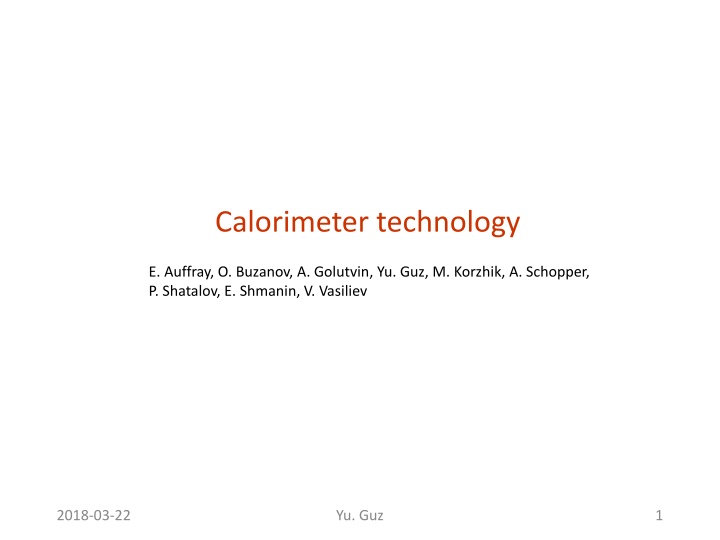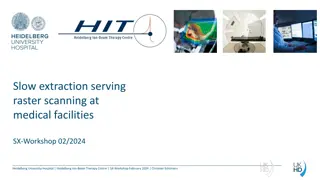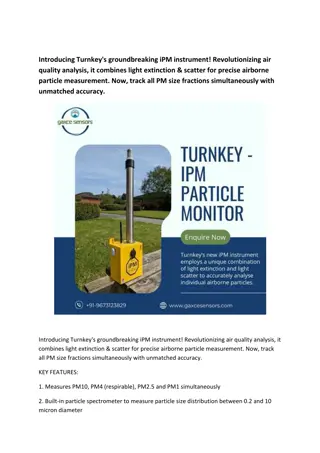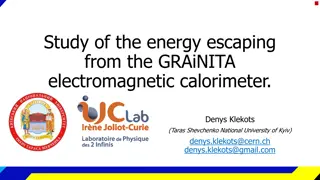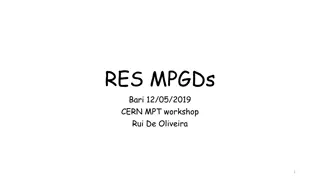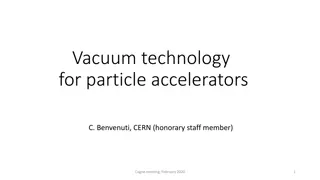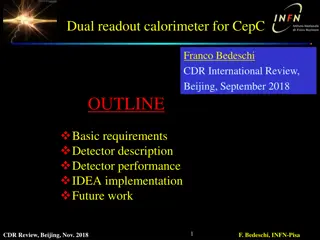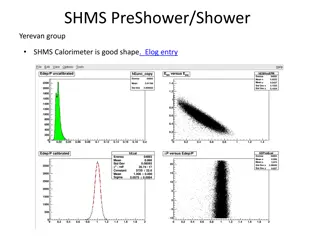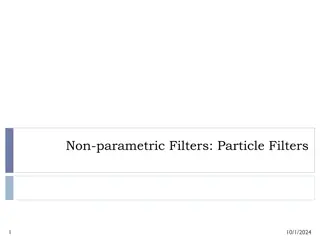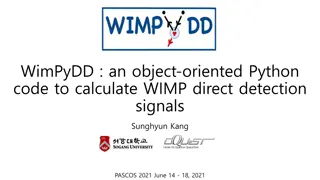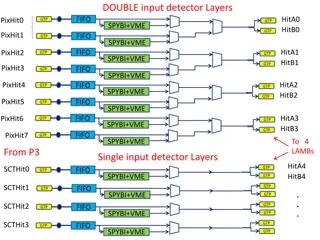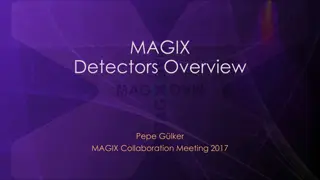Advanced Calorimeter Technology for Particle Detection
Cutting-edge calorimeter technology for high-energy physics experiments is discussed in this content. The focus is on radiation-hard crystal scintillators and plastic scintillator-based Shashlik technology used in the present ECAL. Details about the requirements, materials, irradiation tests, and advancements in scintillation properties are covered, providing insights into the innovative solutions for detecting particles in extreme conditions.
Download Presentation

Please find below an Image/Link to download the presentation.
The content on the website is provided AS IS for your information and personal use only. It may not be sold, licensed, or shared on other websites without obtaining consent from the author.If you encounter any issues during the download, it is possible that the publisher has removed the file from their server.
You are allowed to download the files provided on this website for personal or commercial use, subject to the condition that they are used lawfully. All files are the property of their respective owners.
The content on the website is provided AS IS for your information and personal use only. It may not be sold, licensed, or shared on other websites without obtaining consent from the author.
E N D
Presentation Transcript
Calorimeter technology E. Auffray, O. Buzanov, A. Golutvin, Yu. Guz, M. Korzhik, A. Schopper, P. Shatalov, E. Shmanin, V. Vasiliev 2018-03-22 Yu. Guz 1
ECAL centre - requirements Plastic scintillator based Shashlik technology (present ECAL): works till 30-50 kGy. Periphery: can be shashlik (necessary granularity to be evaluated by MC) Central cells (150-250 modules): radiation hard active medium inorganic scintillators radiation hard photo detectors cooling ? small cell size 4 1032 4x4 cm2 2 1034 ??? (waiting for MC) Moli re radius should match (?) up to ~1 MGy in the centre (no safety factor) (Matthias Karacson, preliminary). Neutrons: up to few 1015/cm2 1 MeV neq + need to perform precise timing measurements for EM showers for the whole ECAL surface 2018-03-22 Yu. Guz 2
radiation hard crystal scintillators Crystals with orthosilicate and garnet structure are proven to be radiation hard. Scintillation: doping with Ce (~1%). Very fast rise time, relatively slow decay time E.Auffray, Upgrade Ib/II calorimeter meeting, 23-Feb-2018 2018-03-22 Yu. Guz 3
radiation hard crystal scintillators Codoping: allows to improve the scintillation properties of garnets (decay time). E.Auffray, Upgrade Ib/II calorimeter meeting, 23-Feb-2018 2018-03-22 Yu. Guz 4
radiation hard crystal scintillators One of promising candidates is a multi-doped GAGG:Ce, with Mg and Ti 4 samples received from FOMOS (Moscow) for our tests 20x20x10 mm3 1 pc 20x20x2 mm3 3 pc Irradiation tests were performed at the IRRAD facility @PS CERN 36 ns: 74% 101 ns: 26% left not irradiated irradiated Measurements: Scintillation signal shape (for non irradiated ) Transparency before and after irradiation -spectroscopy (by RP div.) 2018-03-22 Yu. Guz 5
Irradiation at IRRAD @ PS, Nov 17 Dec 4, 2017 + Al foil dosimeters in each section Actual (Al foils) Requested 4.92 1014 1.26 1015 37 Mrad in GAGG 3.08 1015 91 Mrad in GAGG 2018-03-22 Yu. Guz 6
Transparency degradation - I 1 cm thick sample before irradiation after irradiation (3.08 1015 p/cm2) At important wavelengths: -3.6% @520nm -2.5% @540nm -1.8% @560nm The transparency degradation @ >480 nm measured with the 1 cm sample. For both 2mm thick samples, the degradation cannot be measured reliably. 2018-03-22 Yu. Guz 7
Transparency degradation - II 1 cm thick sample (3.08 1015 p/cm2) At important wavelengths: RIAC=3.6 m-1@520nm 2.5 m-1@540nm 1.8 m-1@560nm The transparency degradation @ >480 nm was measured with the 1 cm thick sample. For both 2mm thick samples, the degradation is not well measurable. Very good result compared to other inorganic scintillators! Do we need separate run of neutron irradiation? 2018-03-22 Yu. Guz 8
Induced activity -spectroscopy by RP division (N. Riggaz) (data for the 20x20x10 mm3 shown). Radio luminescence Isotopes (Bq /Unit) As-74 Se-75 Rb-83 Rb-84 Sr-85 Y-88 Zr-88 Ag-105 Sn-113 Te-121 Xe-127 Ba-131 Ce-139 Isotopes (Bq /Unit) Be-7 Na-22 Sc-46 V-48 Cr-51 Mn-54 Co-56 Co-57 Co-58 Fe-59 Co-60 Zn-65 Zn-72 Decent agreement with Fluka (M. Korzhik et al). Isotopes Pm-143 Pm-144 Eu-146 Gd-146 Eu-147 Eu-148 Pm-148m 3.54E+04 Eu-149 Gd-149 Gd-151 Gd-153 Eu-156 (Bq /Unit) 1.04E+05 2.50E+04 6.96E+04 6.89E+04 2.81E+05 2.34E+05 Activation level after the irradiation to these doses (370 & 910 kGy) is quite high (see ). Radio luminescence in irradiated scintillator occurs as scintillations caused by the decays of the generated isotopes. 1.14E+04 3.13E+04 6.43E+04 1.73E+04 6.84E+04 3.20E+04 8.59E+04 7.93E+04 1.35E+05 9.49E+04 1.89E+05 5.64E+04 1.97E+05 7.23E+05 1.96E+04 7.52E+04 4.39E+04 1.63E+05 4.95E+04 3.54E+04 5.54E+04 1.85E+05 3.31E+04 8.51E+03 1.88E+05 1.55E+04 4.08E+05 2.85E+04 2.75E+05 2.58E+05 1.13E+05 the signal/noise ratio depends on particular calorimeter design and data taking profile first rough estimations: the ratio of MIP signal to radio luminescence noise is >~ 1000 in 25 - 100 ns gate the work on Fluka simulation is ongoing 2.5E+05 Experiment FLUKA 2.0E+05 1.5E+05 Bq/cm3 1.0E+05 5.0E+04 0.0E+00 Zn-65 Mn-54 Zr-88 Pm-143 Pm-144 Cr-51 Rb-83 Rb-84 Sr-85 Y-88 Sn-113 Eu-146 Eu-147 Eu-148 Eu-149 Eu-156 Gd-146 Gd-149 Gd-151 Gd-153 Na-22 Sc-46 V-48 Co-56 Co-57 Co-58 Fe-59 Co-60 As-74 Xe-127 Ba-131 Be-7 Se-75 Te-121 Ce-139 2018-03-22 Yu. Guz 9
possible ECAL technologies - I PoS(ICHEP2016)239 Shashlik Originally consists of LYSO and W layers and WLS filled capillaries. Other crystals can be used, WLS should match R. Ruchti, CPAD2016, Caltech, 2016 The light yield is moderate because of WLS Cons: complexity of production Pros: good radiation hardness (small light path in crystal) low Moli re radius achievable (13 mm @GAAG:W=1:1) reasonable resolution 2018-03-22 Yu. Guz 10
possible ECAL technologies Homogeneous calorimeter With longitudinal segmentation as an option. Fixed Moli re radius (e.g., 20 mm for GAGG) but performance benefits from longitudinal segmentation with longitudinal segmentation: either need photo detectors which are rad hard at room temperature GaAs photo diodes may be a good candidate, studies are ongoing or cool down the whole detector scintillator Photo detectors Pros: perfect if all components are available timing measurement at ~ shower max insensitive to shower longitudinal fluctuations radiation hardness improves with increasing longitudinal segmentation Cons: may need cooling of the whole detector -> not easy to integrate into the ECAL centre 2018-03-22 Yu. Guz 11
possible ECAL technologies Crystal Spacal can be cheaper than other designs smaller Moli re radius possible but: radiation tolerance can be worse (long light path) can be mitigated by double side readout E.Auffray, Upgrade Ib/II calorimeter meeting, 23-Feb-2018 2018-03-22 Yu. Guz 12
possible ECAL technologies Crystal Spacal YAG:Ce square fibers in a 0,75W/0.25Cu Absorber 60*60*200mm3, ~ 1200 holes Equivalent of 3*3 PWO crystals N. Siegrist, H. Gerwig, CERN E.Auffray, Upgrade Ib/II calorimeter meeting, 23-Feb-2018 2018-03-22 Yu. Guz 13
Time measurements Two options: either build a dedicated timing layer either separate detector (preshower) or silicon layers embedded into the ECAL structure or perform the timing measurements with ECAL itself if possible CMS PbWO4 ECAL module has demonstrated very good time resolution (~20 ps) at the test beam To be checked with Shashlik (asap) and Crystal modules (when prototype is available). Need electronics with sampling rate >100 MS/s at least For good time resolution, it may require to use semiconductor photo detectors, no PMTs 2018-03-22 Yu. Guz 14
Conclusions The central part of ECAL can be done on the basis of crystal scintillators; plastic scintillator based Shashlik (present design) at the periphery There are several technologies and several rad hard crystal scintillators which can be used for the central part. Samples of GAGG:Ce (Mg, Ti) scintillator were received and tested very promising results! next steps: work on technology choice and prototype design for the central module (GAGG) do we need neutron irradiation of GAGG? timing measurements with Shashlik (and new prototypes) 2018-03-22 Yu. Guz 15
Acknowledgements We are greatly indebted to: the IRRAD team for all the work of irradiation and dosimetry; Nicolas Riggaz (RP) for gamma spectroscopy of the samples Sasha Singovsky (CMS) for the great help in the measurements Yuri Musienko (CMS), Matthias Karacson (LHCb) for many fruitful discussions. 2018-03-22 Yu. Guz 16
